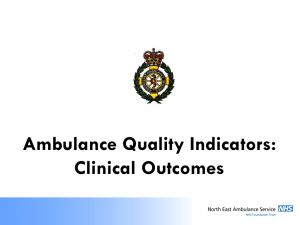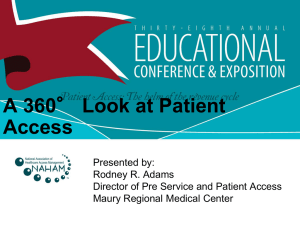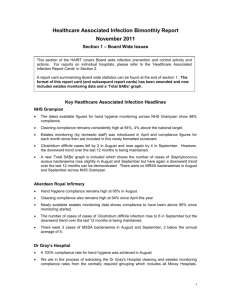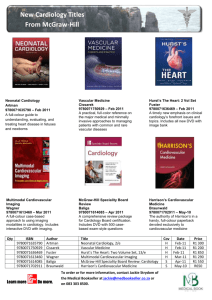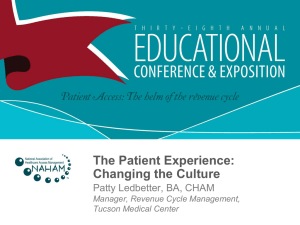Healthcare Associated Infection Reporting
advertisement
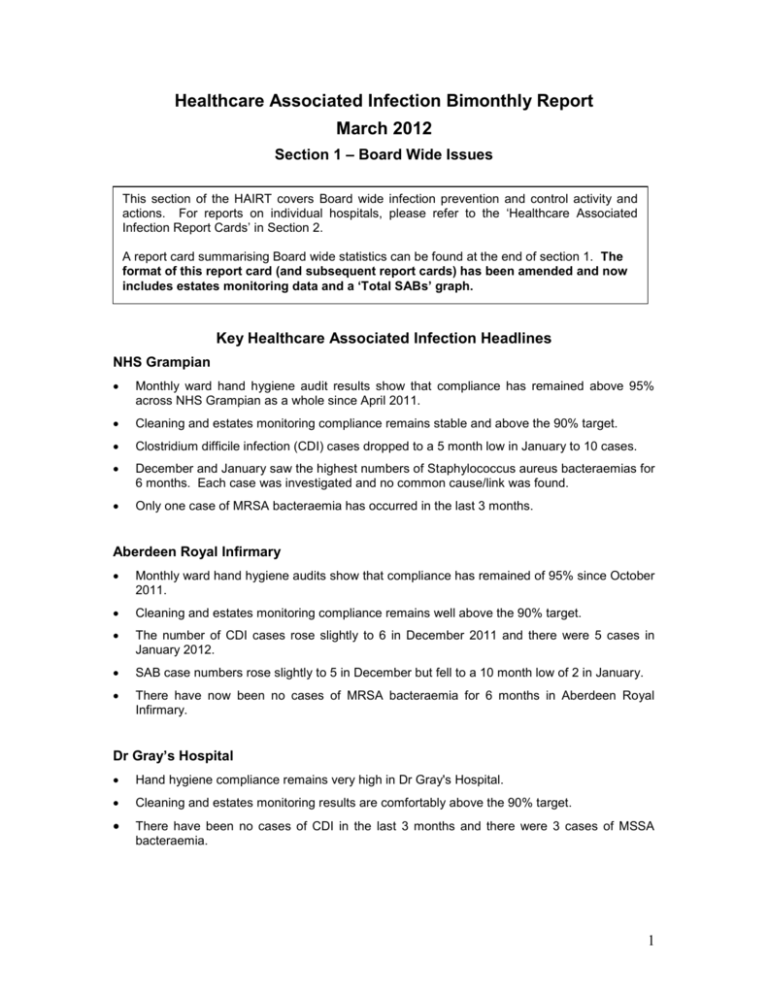
Healthcare Associated Infection Bimonthly Report March 2012 Section 1 – Board Wide Issues This section of the HAIRT covers Board wide infection prevention and control activity and actions. For reports on individual hospitals, please refer to the ‘Healthcare Associated Infection Report Cards’ in Section 2. A report card summarising Board wide statistics can be found at the end of section 1. The format of this report card (and subsequent report cards) has been amended and now includes estates monitoring data and a ‘Total SABs’ graph. Key Healthcare Associated Infection Headlines NHS Grampian Monthly ward hand hygiene audit results show that compliance has remained above 95% across NHS Grampian as a whole since April 2011. Cleaning and estates monitoring compliance remains stable and above the 90% target. Clostridium difficile infection (CDI) cases dropped to a 5 month low in January to 10 cases. December and January saw the highest numbers of Staphylococcus aureus bacteraemias for 6 months. Each case was investigated and no common cause/link was found. Only one case of MRSA bacteraemia has occurred in the last 3 months. Aberdeen Royal Infirmary Monthly ward hand hygiene audits show that compliance has remained of 95% since October 2011. Cleaning and estates monitoring compliance remains well above the 90% target. The number of CDI cases rose slightly to 6 in December 2011 and there were 5 cases in January 2012. SAB case numbers rose slightly to 5 in December but fell to a 10 month low of 2 in January. There have now been no cases of MRSA bacteraemia for 6 months in Aberdeen Royal Infirmary. Dr Gray’s Hospital Hand hygiene compliance remains very high in Dr Gray's Hospital. Cleaning and estates monitoring results are comfortably above the 90% target. There have been no cases of CDI in the last 3 months and there were 3 cases of MSSA bacteraemia. 1 Woodend Hospital Hand hygiene audit results for Woodend Hospital over the last 3 months are below the national target of 90%. This may due to difficulties with reporting and investigation is under way. Cleaning monitoring compliance remains stable and estates monitoring compliance has improved slightly during the current reporting period. There have been no cases of CDI in Woodend Hospital since September 2011 and single cases of MSSA bacteraemia in December and January 2001-12. Community Hospitals Due to the size of these hospitals and the number of SABs and CDIs, Aberdeen Maternity Hospital, Royal Cornhill Hospital, Royal Aberdeen Children's Hospital and Roxburgh House figures are included in this scorecard. There were single cases of CDI in December and January but no SABs. Out of Hospital More than half of the CDIs and SABs that occurred in December and January were diagnosed outwith hospital or within 48 hours of being admitted to hospital. A single case of MRSA bacteraemia was diagnosed in January 2012 Staphylococcus aureus (including MRSA) Staphylococcus aureus is an organism which is responsible for a large number of healthcare associated infections, although it can also cause infections in people who have not had any recent contact with the healthcare system. The most common form of this is Meticillin Sensitive Staphylococcus Aureus (MSSA), but the more well known is MRSA (Meticillin Resistant Staphylococcus Aureus), which is a specific type of the organism which is resistant to certain antibiotics and is therefore more difficult to treat. More information on these organisms can be found at: Staphylococcus aureus : http://www.nhs24.com/content/default.asp?page=s5_4&articleID=346 MRSA: http://www.nhs24.com/content/default.asp?page=s5_4&articleID=252 NHS Boards carry out surveillance of Staphylococcus aureus blood stream infections, known as bacteraemias. These are a serious form of infection and there is a national target to reduce them. The number of patients with MSSA and MRSA bacteraemias for the Board can be found at the end of section 1 and for each hospital in section 2. Information on the national surveillance programme for Staphylococcus aureus bacteraemias can be found at: http://www.hps.scot.nhs.uk/haiic/sshaip/publicationsdetail.aspx?id=30248 Current HEAT Status The Health Protection Scotland quarterly report on the surveillance of Staphylococcus aureus bacteraemias which was published on 11 January 2012 showed that between 1 July and 30 September 2011 the reported SAB rate in NHS Grampian was 0.257 episodes per 1000 acute occupied bed days (AOBDs) compared with 0.304 for NHS Scotland as a whole. 2 For MRSA bacteraemia the rate was 0.015 episodes per 1000 AOBDs compared with 0.038 in NHS Scotland. For MSSA bacteraemia the rate was 0.242 cases per 1000 AOBDs compared with 0.266 in NHS Scotland. NHS Grampian’s MRSA and MSSA bacteraemia rates were lower than the national average for this quarter. Clostridium difficile Clostridium difficile is an organism which is responsible for a large number of healthcare associated infections, although it can also cause infections in people who have not had any recent contact with the healthcare system. More information can be found at: http://www.nhs.uk/conditions/Clostridium-difficile/Pages/Introduction.aspx NHS Boards carry out surveillance of Clostridium difficile infections (CDI), and there is a national target to reduce these. The number of patients with CDI for the Board can be found at the end of section 1 and for each hospital in section 2. Information on the national surveillance programme for Clostridium difficile infections can be found at: http://www.hps.scot.nhs.uk/haiic/sshaip/ssdetail.aspx?id=277 Current HEAT Status The HPS quarterly report on the surveillance of CDI which was also published on 11 January 2012 showed that between 1 July and 30 September 2011 the reported CDI rate in patients over 65 years old in NHS Grampian was 0.27 episodes per 1000 total occupied bed days (TOBDs) compared with 0.32 for NHS Scotland as a whole. This is the 3rd consecutive quarter than the NHS Grampian rate has been lower than the national rate. Hand Hygiene Good hand hygiene by staff, patients and visitors is a key way to prevent the spread of infections. More information on the importance of good hand hygiene can be found at: http://www.washyourhandsofthem.com/ NHS Boards monitor hand hygiene and ensure a zero tolerance approach to non compliance. The hand hygiene compliance score for the Board can be found at the end of section 1 and for each hospital in section 2. Information on national hand hygiene monitoring can be found at: http://www.hps.scot.nhs.uk/haiic/ic/nationalhandhygienecampaign.aspx The NHS Hand Hygiene Campaign 17th Bi-monthly Audit Report which was published on 24 January 2012 confirmed that NHS Grampian achieved a compliance figure of 98%. 3 Cleaning and the Healthcare Environment Keeping the healthcare environment clean is essential to prevent the spread of infections. NHS Boards monitor the cleanliness of hospitals and there is a national target to maintain compliance with standards above 90%. The cleaning compliance score for the Board can be found at the end of section 1 and for each hospital in section 2. Information on national cleanliness compliance monitoring can be found at: http://www.hfs.scot.nhs.uk/online-services/publications/hai/ Healthcare environment standards are also independently inspected by the Healthcare Environment Inspectorate. More details can be found at: http://www.nhshealthquality.org/nhsqis/6710.140.1366.html Cleaning and Estates Monitoring No new national reports have been published since the last HAI Bimonthly Report. However, local data suggests that there has been a slight improvement in estates monitoring compliance within Woodend Hospital. This suggests that the root cause analysis of the non-reporting of estates issues by hospital management and the monitoring teams is starting to have some impact. However, as stated in the previous report, the longer term strategy for the Woodend Hospital site is to vacate the older buildings to modern upgraded facilities. This plan is subject to the usual limitations of funding prioritisation and overall risk management and reduction across the Board’s physical estate. Healthcare Environment Inspectorate (HEI) The HEI performed an unannounced inspection of Dr Gray’s Hospital, Elgin on 11 January 2012. This inspection resulted in 2 recommendations only (no requirements). The updated action plan is shown below: Action Planned Timescale Responsibility Progress Date to meet for taking Completed action action NHS Grampian should develop a comprehensive system of accountability aligned to the new procedure for the cleaning of patient equipment A performance framework April 2012 Divisional Initial discussion with In progress will be developed and General Health Improvement implemented Manager Scotland have taken place NHS Grampian should consider presenting surveillance information in a way that is more meaningful to children, parents and visitors The Infection Prevention and Control Nurse will liaise with the Senior Charge Nurse to introduce the child friendly posters that were developed for Royal Aberdeen Children’s Hospital. Complete Infection Prevention and Control Nurse/Infection Control Manager Permission granted to use posters in paediatric ward. 1 March Posters printed, laminated and on display. 4 Incidents and Outbreaks Norovirus Prevalence Monday Point Prevalence Surveillance figures are reported to Health Protection Scotland. These capture the significant outbreaks of Norovirus in NHS Grampian and the prevalence of Norovirus activity in close to real time. They are not, and should not be interpreted as data for benchmarking or judgement. The data can be used for the assessment of risk and Norovirus outbreak preparedness only. During January and February 2012 the following instances of Norovirus were submitted: On Monday 2 January, 1 hospital in NHS Grampian had 1 ward closed with 7 patients and no staff members affected. On Monday 9 January, 3 hospitals in NHS Grampian had a total of 4 wards closed with 17 patients and 8 staff members affected. On Monday 30 January, 1 hospital in NHS Grampian had 2 wards closed with 5 patients and 1 staff member affected. On Monday 13 February, 1 hospital in NHS Grampian had 1 ward closed with 3 patients and 2 staff members affected. On Monday 20 February, 1 hospital in NHS Grampian had 1 ward closed with 3 patients and no staff members affected. On Monday 27 February, 1 hospital in NHS Grampian had 2 wards closed with 7 patients and 2 staff members affected. Tuberculosis Incident, Aberdeen Royal Infirmary (ARI) A patient, from a country with a high incidence of tuberculosis (TB), was admitted to ARI on two occasions with symptoms suggestive of TB. However, TB was not initially considered as a diagnosis and therefore there was a delay in isolating the case. Seventeen patient contacts were assessed and 11 were offered screening for TB infection. One patient has been started on treatment for TB but this is not thought to be connected to contact with the case. The recommendations below have been implemented: All patients admitted with symptoms compatible with a possible diagnosis of pulmonary TB should have 3 sputum samples obtained and sent for microscopy and subsequent culture. Ideally, when possible, samples should be obtained first thing in the morning on consecutive days. Action needs to be taken to raise awareness amongst all grades of medical staff of the need to consider inclusion of pulmonary TB disease in their differential diagnosis of patients who give a history of relevant respiratory symptoms. This is especially important when the patient exhibits classic risk factors for TB infection. Suspected Legionella at Aberdeen Royal Infirmary All cases of suspected/confirmed Legionella should be investigated in a timely manner in accordance with the Health Protection Network: Guideline on Management of Legionella Incidents, Outbreaks and Clusters March 2009. 5 In January 2012 a patient at ARI was investigated for suspected Legionella. As the incubation period for Legionella is up to 10 days it was considered possible that the infection could have been acquired either in hospital or the community therefore both potential sources were investigated. An Incident Management Team (IMT) was convened on 9 January and stood down on 12 January following receipt of the negative results from the reference laboratory that indicated a false positive result from the local laboratory. Given the initial information available the response to this incident was appropriate. The management of this incident has been reviewed and the key recommendations are summarised below: NHS Grampian Legionella laboratory protocol should be reviewed. There should be an early discussion between the treating physician microbiology and public health to agree the most likely diagnosis prior to any action being taken. NHSG Legionella Operational Procedures should be revised with input from Public Health A permanent teleconference bridge should be in place to support the management of public health incidents 6 NHS Grampian Total Staphylococcus aureus Bacteraemia Cases (all ages) Monthly ward hand hygiene audit results show that compliance has remained above 95% across NHS Grampian as a whole since April 2011. Cleaning and estates monitoring compliance remains stable and above the 90% target. Clostridium difficile infection (CDI) cases dropped to a 5 month low in January to 10 cases. December and January saw the highest numbers of Staphylococcus aureus bacteraemias for 6 months. Each case was investigated and no common cause/link was found. Only one case of MRSA bacteraemia has occurred in the last 3 months. Mar-11 97 Apr-11 94 May-11 96 Jun-11 95 Jul-11 95 Aug-11 98 Sep-11 96 Oct-11 97 25 20 15 10 5 0 Feb-11 Feb-11 5 Hand Hygiene Monitoring Compliance (%) Feb-11 94 30 Nov-11 96 Dec-11 98 Mar-11 Mar-11 15 Apr-11 Apr-11 15 May-11 May-11 14 Jan-12 96 Jun-11 Jun-11 21 Jul-11 Jul-11 10 Aug-11 Aug-11 12 Sep-11 Sep-11 13 Oct-11 Nov-11 Oct-11 12 Dec-11 Nov-11 7 Jan-12 Dec-11 16 Jan-12 14 MRSA Bacteraemia Cases (all ages) 30 25 Cleaning Compliance (%) Feb-11 93 Mar-11 93 Apr-11 93 May-11 92 Jun-11 94 Jul-11 94 Aug-11 94 Sep-11 94 Oct-11 95 Nov-11 94 Dec-11 94 Jan-12 94 20 15 10 5 Estates Monitoring Compliance (%) Feb-11 Mar-11 Apr-11 93 May-11 93 Jun-11 92 Jul-11 92 Aug-11 92 Sep-11 92 Oct-11 93 Nov-11 92 Dec-11 94 Jan-12 94 0 Feb-11 Feb-11 1 Mar-11 Mar-11 1 Apr-11 Apr-11 3 Clostridium difficile Cases (all ages) May-11 1 Jun-11 Jun-11 1 Jul-11 Jul-11 1 Aug-11 Aug-11 0 Sep-11 Sep-11 0 Oct-11 Nov-11 Oct-11 1 Dec-11 Nov-11 0 Jan-12 Dec-11 0 Jan-12 1 MSSA Bacteraemia Cases (all ages) 30 30 100 25 25 80 20 20 60 15 15 10 40 10 5 20 5 00 0 Feb-11 Feb-11 13 May-11 Mar-11 Mar-11 11 Apr-11 Apr-11 14 May-11 May-11 14 Jun-11 Jun-11 18 Jul-11 Jul-11 11 Aug-11 Aug-11 9 Sep-11 Sep-11 15 Oct-11 Nov-11 Oct-11 13 Dec-11 Nov-11 14 Jan-12 Dec-11 16 Feb-11 Feb-11 Mar-11 Mar-11 Apr-11 Apr-11 Jan-12 10 Feb-11 4 Mar-11 14 Apr-11 12 May-11 May-11 May-11 13 Jun-11 Jun-11 Jun-11 20 Jul-11 Jul-11 Jul-11 9 Aug-11 Aug-11 Aug-11 12 Sep-11 Sep-11 13 Oct-11 Oct-11 Nov-11 Nov-11 Oct-11 11 Dec-11 Dec-11 Nov-11 7 Jan-12 Jan-12 Dec-11 16 Jan-12 13 7 Quarterly rolling year Clostridium difficile Infection Cases (aged 65 and over) per 1000 total occupied bed days for HEAT Target Measurement 1 0.9 0.8 0.7 0.6 0.5 0.4 0.3 0.2 0.1 0 Apr 10 Mar 11 Jul 10 Jun 11 Oct 10 Sept 11 Jan 11 Dec 11 Apr 11 Mar 12 Jul 11 Jun 12 Actual Performance Actual Performance Target Oct 11 Sept 12 Jan 12 Dec 12 Apr 12 Mar 13 Target Apr 10 Mar 11 Jul 10 Jun 11 Oct 10 Sept 11 Jan 11 Dec 11 Apr 11 Mar 12 Jul 11 Jun 12 Oct 11 Sept 12 Jan 12 Dec 12 Apr 12 Mar 13 0.41 0.89 0.36 0.52 0.30 0.50 0.49 0.47 0.45 0.43 0.41 0.39 Quarterly rolling year Staphylococcus aureus Bacteraemia Rates per 1000 Acute Occupied Bed Days for HEAT Target Measurement 0.4 0.35 0.3 0.25 0.2 0.15 0.1 0.05 0 Apr 10 Mar 11 Jul 10 Jun 11 Oct 10 Sept 11 Actual Performance Target Jan 11 Apr 11 Dec 11 Mar 12 Actual Performance Jul 11 Jun 12 Oct 11 Sept 12 Jan 12 Dec 12 Apr 12 Mar 13 Target Apr 10 Mar 11 Jul 10 Jun 11 Oct 10 Sept 11 Jan 11 Dec 11 Apr 11 Mar 12 Jul 11 Jun 12 Oct 11 Sept 12 Jan 12 Dec 12 Apr 12 Mar 13 0.36 0.36 0.32 0.34 0.31 0.30 0.29 0.28 0.28 0.27 0.26 8 Healthcare Associated Infection Reporting Template (HAIRT) Section 2 – Healthcare Associated Infection Report Cards The following section is a series of ‘Report Cards’ that provide information, for each acute hospital [and key community hospitals] in the Board, on the number of cases of Staphylococcus aureus blood stream infections (also broken down into MSSA and MRSA) and Clostridium difficile infections, as well as hand hygiene, cleaning and estates monitoring compliance. In addition, there is a single report card which covers all community hospitals [which do not have individual cards], and a report which covers infections identified as having been contracted from outwith hospital. The information in the report cards is provisional local data, and may differ from the national surveillance reports carried out by Health Protection Scotland and Health Facilities Scotland. The national reports are official statistics which undergo rigorous validation, which means final national figures may differ from those reported here. However, these reports aim to provide more detailed and up to date information on HAI activities at local level than is possible to provide through the national statistics. Understanding the Report Cards – Infection Case Numbers Clostridium difficile infections (CDI) and Staphylococcus aureus bacteraemia (SAB) cases are presented for each hospital, broken down by month. Staphylococcus aureus bacteraemia (SAB) cases are further broken down into Meticillin Sensitive Staphylococcus aureus (MSSA) and Meticillin Resistant Staphylococcus aureus (MRSA). Data are presented as both a graph and a table giving case numbers. More information on these organisms can be found on the NHS24 website: Clostridium difficile : http://www.nhs24.com/content/default.asp?page=s5_4&articleID=2139&sectionID=1 Staphylococcus aureus : http://www.nhs24.com/content/default.asp?page=s5_4&articleID=346 MRSA: http://www.nhs24.com/content/default.asp?page=s5_4&articleID=252&sectionID=1 For each hospital the total number of cases for each month are those which have been reported as positive from a laboratory report on samples taken more than 48 hours after admission. For the purposes of these reports, positive samples taken from patients within 48 hours of admission will be considered to be confirmation that the infection was contracted prior to hospital admission and will be shown in the “out of hospital” report card. Understanding the Report Cards – Hand Hygiene Compliance Good hand hygiene is crucial for infection prevention and control. More information can be found from the Health Protection Scotland’s national hand hygiene campaign website: http://www.washyourhandsofthem.com/ Hospitals carry out regular audits of how well their staff are complying with hand hygiene. The first page of each hospital report card presents the percentage of hand hygiene compliance for all staff in both graph and table form. Understanding the Report Cards – Cleaning Compliance Hospitals strive to keep the care environment as clean as possible. This is monitored through cleaning compliance audits. More information on how hospitals carry out these audits can be found on the Health Facilities Scotland website: http://www.hfs.scot.nhs.uk/online-services/publications/hai/ The first page of each hospital Report Card gives the hospitals cleaning compliance percentage in both graph and table form. Understanding the Report Cards – ‘Out of Hospital Infections’ Clostridium difficile infections and Staphylococcus aureus (including MRSA) bacteraemia cases are all associated with being treated in hospitals. However, this is not the only place a patient may contract an infection. This total will also include infection from community sources such as GP surgeries and care homes and. The final Report Card report in this section covers ‘Out of Hospital Infections’ and reports on SAB and CDI cases reported to a Health Board which are not attributable to a hospital. Given the complex variety of sources for these infections it is not possible to break this data down in any more detail. 9 Aberdeen Royal Infirmary Total Staphylococcus aureus Bacteraemia Cases (all ages) Monthly ward hand hygiene audits show that compliance has remained of 95% since October 2011. Cleaning and estates monitoring compliance remains well above the 90% target. The number of CDI cases rose slightly to 6 in December 2011 and there were 5 cases in January 2012. SAB case numbers rose slightly to 5 in December but fell to a 10 month low of 2 in January. There have now been no cases of MRSA bacteraemia for 6 months in Aberdeen Royal Infirmary. 9 8 7 6 5 4 3 2 1 0 Feb-11 Feb-11 2 Hand Hygiene Monitoring Compliance (%) Feb-11 96 Mar-11 95 Apr-11 75 May-11 95 Jun-11 97 Jul-11 96 Aug-11 95 Sep-11 94 Oct-11 92 Nov-11 98 Dec-11 98 Mar-11 93 Apr-11 94 May-11 94 Feb-11 Mar-11 Apr-11 95 May-11 94 Jun-11 94 Jul-11 94 Aug-11 94 Sep-11 94 Oct-11 95 Jul-11 96 Aug-11 93 Sep-11 92 Oct-11 94 Apr-11 2 Nov-11 95 Dec-11 94 Jan-12 95 Nov-11 94 Dec-11 94 Jan-12 96 May-11 5 Jun-11 Jun-11 8 Jul-11 Jul-11 5 Aug-11 Aug-11 3 Sep-11 Sep-11 3 Oct-11 Nov-11 Oct-11 4 Dec-11 Nov-11 3 Jan-12 Dec-11 5 Jan-12 2 10 9 8 7 6 5 4 3 2 1 0 Feb-11 Feb-11 1 Mar-11 Mar-11 0 Apr-11 Apr-11 0 Clostridium difficile Cases (all ages) May-11 May-11 0 Jun-11 Jun-11 1 Jul-11 Jul-11 1 Aug-11 Aug-11 0 Sep-11 Sep-11 0 Oct-11 Nov-11 Oct-11 0 Dec-11 Nov-11 0 Jan-12 Dec-11 0 Jan-12 0 MSSA Bacteraemia Cases (all ages) 10 8 100 9 7 80 6 8 7 6 560 5 4 4 340 3 2 20 1 2 1 00 0 Feb-11 Feb-11 4 May-11 MRSA Bacteraemia Cases (all ages) Estates Monitoring Compliance (%) Jun-11 93 Mar-11 3 Apr-11 Jan-12 99 Cleaning Compliance (%) Feb-11 94 Mar-11 Mar-11 Mar-11 3 Apr-11 Apr-11 3 May-11 May-11 4 Jun-11 Jun-11 4 Jul-11 Jul-11 2 Aug-11 Aug-11 2 Sep-11 Sep-11 5 Oct-11 Nov-11 Oct-11 4 Dec-11 Nov-11 4 Jan-12 Dec-11 6 Feb-11 Feb-11 Mar-11 Mar-11 Apr-11 Apr-11 May-11 May-11 Jun-11 Jun-11 Jan-12 5 3.833333 Feb-11 1 Mar-11 3 Apr-11 2 May-11 5 Jun-11 7 Jul-11 Jul-11 Jul-11 4 Aug-11 Aug-11 Aug-11 3 Sep-11 Sep-11 Sep-11 3 Oct-11 Nov-11 Nov-11 Oct-11 4 Dec-11 Dec-11 Nov-11 3 Jan-12 Jan-12 Dec-11 5 Jan-12 2 10 Dr Gray's Hospital Total Staphylococcus aureus Bacteraemia Cases (all ages) 3 Hand hygiene compliance remains very high in Dr Gray's Hospital. Cleaning and estates monitoring results are comfortably above the 90% target. There have been no cases of CDI in the last 3 months and there were 3 cases of MSSA bacteraemia. 2 1 0 Feb-11 Feb-11 0 Hand Hygiene Monitoring Compliance (%) Feb-11 96 Mar-11 98 Apr-11 99 May-11 99 Jun-11 94 Jul-11 92 Aug-11 100 Sep-11 100 Oct-11 99 Nov-11 99 Dec-11 99 Mar-11 Mar-11 1 Apr-11 Apr-11 1 May-11 May-11 1 Jan-12 100 Jun-11 Jun-11 1 Jul-11 Jul-11 1 Aug-11 Aug-11 2 Sep-11 Sep-11 0 Oct-11 Nov-11 Oct-11 2 Dec-11 Nov-11 0 Jan-12 Dec-11 1 Jan-12 2 MRSA Bacteraemia Cases (all ages) 3 Cleaning Compliance (%) Feb-11 Mar-11 Apr-11 May-11 Jun-11 Jul-11 94 Aug-11 93 Sep-11 92 Oct-11 92 Nov-11 92 Dec-11 93 Jan-12 94 2 1 Estates Monitoring Compliance (%) Feb-11 Mar-11 Apr-11 May-11 Jun-11 Jul-11 99 Aug-11 93 Sep-11 98 Oct-11 98 Nov-11 98 Dec-11 97 Jan-12 96 0 Feb-11 Feb-11 0 Mar-11 Mar-11 0 Apr-11 Apr-11 0 Clostridium difficile Cases (all ages) May-11 May-11 1 Jun-11 Jun-11 0 Jul-11 Jul-11 0 Aug-11 Aug-11 0 Sep-11 Sep-11 0 Oct-11 Nov-11 Oct-11 1 Dec-11 Nov-11 0 Jan-12 Dec-11 0 Jan-12 0 MSSA Bacteraemia Cases (all ages) 3 3 100 2 2 60 80 40 1 1 20 00 0 Feb-11 Feb-11 0 Mar-11 Mar-11 0 Apr-11 Apr-11 0 May-11 May-11 0 Jun-11 Jun-11 0 Jul-11 Jul-11 0 Aug-11 Aug-11 1 Sep-11 Sep-11 0 Oct-11 Nov-11 Oct-11 1 Dec-11 Nov-11 0 Jan-12 Dec-11 0 Feb-11 Feb-11 Mar-11 Mar-11 Apr-11 Apr-11 May-11 May-11 Jun-11 Jun-11 Jan-12 0 Feb-11 0 Mar-11 0 Apr-11 0 May-11 1 Jun-11 0 Jul-11 Jul-11 Jul-11 0 Aug-11 Aug-11 Aug-11 0 Sep-11 Sep-11 Sep-11 0 Oct-11 Nov-11 Nov-11 Oct-11 1 Dec-11 Dec-11 Nov-11 0 Jan-12 Jan-12 Dec-11 1 Jan-12 2 11 Woodend Hospital Total Staphylococcus aureus Bacteraemia Cases (all ages) 3 Hand hygiene audit results for Woodend Hospital over the last 3 months are below the national target of 90%. This may due to difficulties with reporting and investigation is under way. Cleaning monitoring compliance remains stable and estates monitoring compliance has improved slightly during the current reporting period. There have been no cases of CDI in Woodend Hospital since September 2011 and single cases of MSSA bacteraemia in December and January 2001-12. 2 1 0 Feb-11 Feb-11 0 Hand Hygiene Monitoring Compliance (%) Feb-11 95 Mar-11 Apr-11 91 May-11 91 Jun-11 90 Jul-11 92 Aug-11 100 Sep-11 Oct-11 100 Nov-11 88 Dec-11 88 Mar-11 Mar-11 2 Apr-11 Apr-11 1 May-11 May-11 0 Jan-12 87 Jun-11 Jun-11 0 Jul-11 Jul-11 1 Aug-11 Aug-11 3 Sep-11 Sep-11 3 Oct-11 Nov-11 Oct-11 0 Dec-11 Nov-11 0 Jan-12 Dec-11 1 Jan-12 1 MRSA Bacteraemia Cases (all ages) 3 Cleaning Compliance (%) Feb-11 88 Mar-11 87 Apr-11 87 May-11 87 Jun-11 88 Jul-11 90 Aug-11 91 Sep-11 91 Oct-11 91 Nov-11 92 Dec-11 92 Jan-12 91 2 1 Estates Monitoring Compliance (%) Feb-11 Mar-11 Apr-11 80 May-11 78 Jun-11 77 Jul-11 80 Aug-11 82 Sep-11 87 Oct-11 84 Nov-11 85 Dec-11 86 Jan-12 86 0 Feb-11 Feb-11 0 Mar-11 Mar-11 0 Apr-11 Apr-11 1 Clostridium difficile Cases (all ages) May-11 May-11 0 Jun-11 Jun-11 0 Jul-11 Jul-11 0 Aug-11 Aug-11 0 Sep-11 Sep-11 0 Oct-11 Nov-11 Oct-11 0 Dec-11 Nov-11 0 Jan-12 Dec-11 0 Jan-12 0 MSSA Bacteraemia Cases (all ages) 3 3 100 2 2 60 80 40 1 1 20 00 0 Feb-11 Feb-11 0 Mar-11 Mar-11 2 Apr-11 Apr-11 0 May-11 May-11 0 Jun-11 Jun-11 1 Jul-11 Jul-11 0 Aug-11 Aug-11 0 Sep-11 Sep-11 1 Oct-11 Nov-11 Oct-11 0 Dec-11 Nov-11 0 Jan-12 Dec-11 0 Feb-11 Feb-11 Mar-11 Mar-11 Apr-11 Apr-11 May-11 May-11 Jun-11 Jun-11 Jan-12 0 Feb-11 0 Mar-11 0 Apr-11 1 May-11 1 Jun-11 0 Jul-11 Jul-11 Jul-11 0 Aug-11 Aug-11 Aug-11 1 Sep-11 Sep-11 Sep-11 3 Oct-11 Nov-11 Nov-11 Oct-11 0 Dec-11 Dec-11 Nov-11 0 Jan-12 Jan-12 Dec-11 1 Jan-12 1 12 Community Hospital Infections Clostridium difficile Infection Cases 3 2 There were single cases of CDI in December and January but no SABs. 1 0 Feb-11 Feb-11 1 Mar-11 Mar-11 0 Apr-11 Apr-11 1 May-11 May-11 2 MSSA Bacteraemia Cases Jun-11 1 Jul-11 Jul-11 1 Aug-11 Aug-11 3 Sep-11 Oct-11 Sep-11 2 Nov-11 Oct-11 0 Dec-11 Nov-11 1 Jan-12 Dec-11 1 Jan-12 1 MRSA Bacteraemia Cases 3 3 2 2 1 1 0 0 Feb-11 Feb-11 0 Jun-11 Mar-11 0 Mar-11 Apr-11 Apr-11 0 May-11 May-11 0 Jun-11 Jun-11 0 Jul-11 Jul-11 0 Aug-11 Aug-11 1 Sep-11 Sep-11 1 Oct-11 Oct-11 0 Nov-11 Dec-11 Nov-11 0 Jan-12 Dec-11 0 Jan-12 0 Feb-11 Feb-11 0 Mar-11 Mar-11 0 Apr-11 Apr-11 0 May-11 May-11 0 Jun-11 Jun-11 0 Jul-11 Jul-11 0 Aug-11 Aug-11 0 Sep-11 Sep-11 0 Oct-11 Nov-11 Oct-11 0 Dec-11 Nov-11 0 Jan-12 Dec-11 0 Jan-12 0 13 Out of Hospital Infections Clostridium difficile Infection Cases 16 14 12 10 More than half of the CDIs and SABs that occurred in December and January were diagnosed outwith hospital or within 48 hours of being admitted to hospital. The single case of MRSA bacteraemia in January 2012 was diagnosed out of hospital. 8 6 4 2 0 Feb-11 Feb-11 8 Mar-11 Mar-11 6 Apr-11 Apr-11 10 May-11 May-11 8 MSSA Bacteraemia Cases Jun-11 12 Jul-11 Jul-11 8 Aug-11 Aug-11 3 Sep-11 Oct-11 Sep-11 7 Nov-11 Oct-11 8 Dec-11 Nov-11 9 Jan-12 Dec-11 9 Jan-12 4 MRSA Bacteraemia Cases 16 16 14 14 12 12 10 10 8 8 6 6 4 4 2 2 0 0 Feb-11 Feb-11 3 Jun-11 Mar-11 10 Mar-11 Apr-11 Apr-11 8 May-11 May-11 7 Jun-11 Jun-11 12 Jul-11 Jul-11 4 Aug-11 Aug-11 5 Sep-11 Sep-11 6 Oct-11 Oct-11 6 Nov-11 Dec-11 Nov-11 4 Jan-12 Dec-11 9 Jan-12 8 Feb-11 Feb-11 0 Mar-11 Mar-11 1 Apr-11 Apr-11 2 May-11 May-11 0 Jun-11 Jun-11 0 Jul-11 Jul-11 0 Aug-11 Aug-11 0 Sep-11 Sep-11 0 Oct-11 Nov-11 Oct-11 0 Dec-11 Nov-11 0 Jan-12 Dec-11 0 Jan-12 1 14

